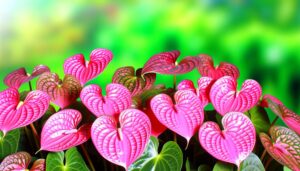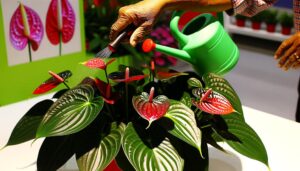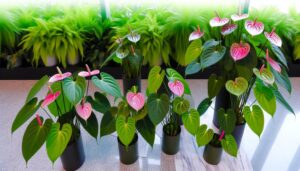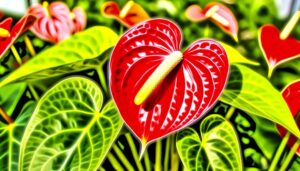Caring for Anthurium Jambo Red: A Complete Guide
To care for your Anthurium Jambo Red, position it in bright, indirect light near an east or north-facing window. Keep the humidity at 70-80% and the temperature between 70-85°F.
Water when the top inch of soil is dry, using filtered or rainwater, and make sure proper drainage. Use a well-draining soil mix rich in organic matter including peat moss, perlite, pine bark, and charcoal.
Repot every 2-3 years using a slightly larger pot. Inspect regularly for pests like spider mites and aphids; treat promptly.
For propagation, divide the plant or use stem cuttings. You'll discover more specifics for perfect care.
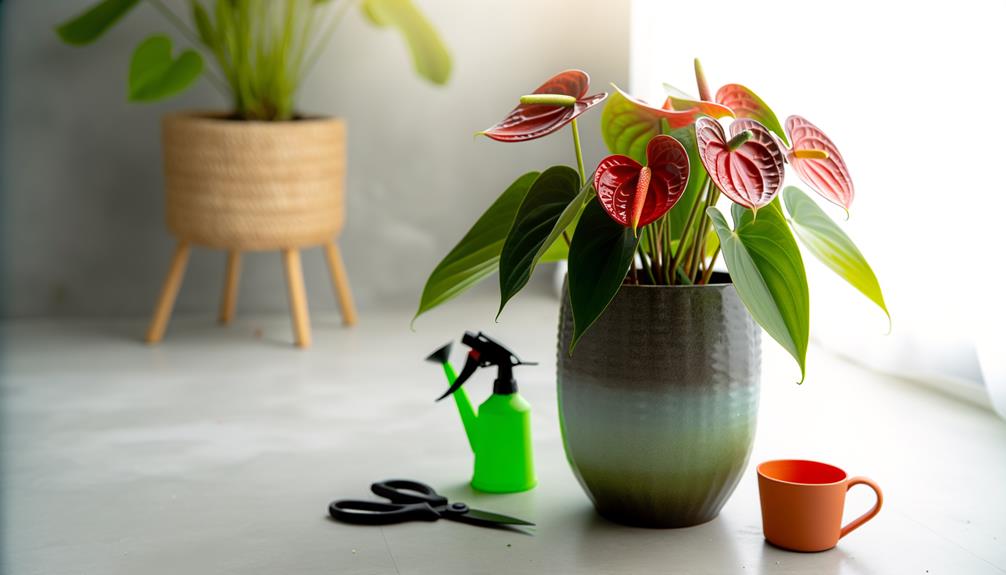
Key Takeaways
- Place Anthurium Jambo Red in bright, indirect light near an east or north-facing window.
- Water when the top inch of soil is dry, using well-draining soil rich in organic matter.
- Maintain 70-80% humidity and a temperature between 70-85°F; use a humidifier if needed.
- Inspect regularly for pests and treat with insecticidal soap; prevent fungal infections with proper watering and ventilation.
- Repot every 2-3 years using a pot 1-2 inches larger, loosening roots gently before replanting.
Ideal Lighting
For best growth, place your Anthurium Jambo Red in bright, indirect light, avoiding direct sunlight to prevent leaf scorch. Position it near an east or north-facing window where it can absorb filtered light.
If natural light is insufficient, use fluorescent or LED grow lights, making certain they're on for 12-14 hours daily. Anthuriums thrive in light levels ranging from 1,000 to 2,000 foot-candles. You can measure light intensity using a light meter for accuracy.
Rotate the plant weekly to secure even light exposure, fostering uniform growth. Avoid placing your Anthurium in low light, as this can lead to leggy growth and reduced flowering.
Watering Schedule
To maintain peak hydration for your Anthurium Jambo Red, water it once the top inch of soil feels dry to the touch.
Be vigilant for signs of overwatering, such as yellowing leaves and root rot.
Guarantee proper drainage to prevent waterlogged soil conditions.
Optimal Watering Frequency
Maintaining an optimal watering schedule for your Anthurium Jambo Red is crucial. You need to water it thoroughly once the top 1-2 inches of soil feel dry to the touch. Use your finger to check the soil moisture. If it's dry at this depth, it's time to water.
Guarantee the water penetrates deeply, reaching the root zone, but avoid waterlogging. Use filtered or rainwater at room temperature to prevent mineral buildup.
Monitor the plant's environment, as temperature and humidity fluctuations will impact watering frequency. During the growing season, typically spring and summer, you may need to water more frequently.
Conversely, reduce watering during the colder months, as the plant's metabolic rate decreases, necessitating less moisture.
Signs of Overwatering
Overwatering your Anthurium Jambo Red can lead to root rot. Symptoms include yellowing leaves, mushy stems, and a foul odor from the soil. When you notice these signs, reduce watering immediately. Ensure the pot has proper drainage to prevent stagnant water that worsens root rot.
Use a well-aerated potting mix rich in organic matter. This type of mix helps retain moisture without waterlogging. To check soil moisture, insert your finger into the soil up to the second knuckle. If it feels damp, avoid watering. For more precision, consider using a moisture meter.
Elevate humidity levels by using a pebble tray instead of excessive watering. Remember, your Anthurium prefers moderate moisture, not saturated conditions. Monitor your plant closely and adjust your care routine accordingly.
Humidity Requirements
To maintain peak growth, make sure the Anthurium Jambo Red experiences humidity levels between 70-80%.
You can increase humidity by using a humidifier or placing the plant on a water-filled pebble tray.
Regular misting also helps to sustain the necessary moisture in the air.
Optimal Humidity Levels
Achieving the ideal moisture level of 60-80% is vital for the health and growth of Anthurium Jambo Red. You should regularly monitor the surrounding moisture using a hygrometer.
This plant thrives in environments resembling its native tropical habitat, where heightened moisture levels are essential for its physiological processes, including transpiration and nutrient uptake. Low moisture can lead to desiccation of leaf tips, stunted growth, and increased susceptibility to pests.
Make sure your Anthurium isn't exposed to dry air from heating vents or air conditioners. Position it away from drafts to maintain consistent moisture levels. If natural moisture is insufficient, consider supplemental measures but remember to prioritize accuracy and consistency to foster prime conditions for your Anthurium's flourishing.
Humidity Increase Techniques
Consider utilizing a humidifier to maintain the necessary 60-80% humidity levels for your Anthurium Jambo Red, securing ideal moisture for its tropical needs. Position the humidifier near the plant but avoid direct misting on the leaves to prevent fungal growth.
Additionally, create a humidity tray by placing pebbles in a shallow dish and filling it with water just below the pebble tops; place the pot on top. This setup aids in evaporative humidity. You can also group your Anthurium with other moisture-loving plants to create a microclimate with higher humidity.
Regularly misting the plant's foliage can help, but make sure it's done in the morning to allow sufficient drying time. These techniques will help you replicate the Anthurium's natural humid environment.
Temperature Needs
Maintaining a consistent temperature range of 70-85°F (21-29°C) is essential for the best growth of Anthurium Jambo Red. You need to guarantee that your plant environment remains stable within this range, as fluctuations can stress the plant.
Avoid placing your Anthurium near drafty windows or air vents, which can cause temperature swings. If you live in a cooler climate, consider using a heat mat to provide additional warmth. Conversely, in hotter regions, guarantee proper ventilation to prevent overheating.
Always monitor ambient conditions with a reliable thermometer. Remember, sudden drops below 60°F (15°C) can impede growth and lead to leaf damage. Your Anthurium will thrive best when you guarantee these precise temperature conditions.
Best Soil Mix
A well-draining soil mix rich in organic matter is essential for the best growth of Anthurium Jambo Red. You'll need to create an environment that mimics their natural tropical habitat.
Start with a base of peat moss to retain moisture without becoming waterlogged.
Add perlite for aeration, improving root oxygenation, and preventing compaction.
Incorporate pine bark to enhance drainage and supply organic material.
Finally, mix in a small amount of charcoal to absorb impurities and improve soil health.
- Peat moss: Retains moisture, prevents waterlogging
- Perlite: Enhances aeration, prevents soil compaction
- Pine bark: Improves drainage, supplies organic matter
- Charcoal: Absorbs impurities, maintains soil health
Fertilizing Tips
When fertilizing your Anthurium Jambo Red, use a balanced, water-soluble fertilizer with an NPK ratio of 20-20-20, diluted to half strength. Apply this solution every four to six weeks during the growing season, typically spring through early fall. Make sure the soil is moist before applying fertilizer to prevent root burn. Pour the diluted fertilizer evenly around the base of the plant, avoiding direct contact with the leaves and stems.
Monitor your plant for any signs of nutrient deficiencies, such as yellowing leaves or stunted growth, and adjust the feeding schedule accordingly. Excessive fertilization can result in salt build-up in the soil, which can harm the roots. Flush the soil with water every few months to prevent this.
Pruning Techniques
Prune your Anthurium Jambo Red by removing dead or damaged leaves with sterilized, sharp cutting shears to promote vigorous growth. This process prevents disease spread and encourages strong foliage. Always prune at the base of the leaf stem, close to the main stem, to avoid leaving stubs that can harbor pathogens.
Follow these steps:
- Inspect weekly: Regularly check for yellowing or damaged leaves.
- Sterilize tools: Use rubbing alcohol or a bleach solution to disinfect cutting shears.
- Prune selectively: Remove only dead or diseased foliage to avoid putting pressure on the plant.
- Monitor regrowth: Observe new growth to guarantee healthy development and promptly address any issues.
Repotting Guide
When repotting your Anthurium Jambo Red, make sure you select a pot that's 1-2 inches larger in diameter than the current one to accommodate root growth.
Use a well-draining soil mix, such as a blend of orchid bark, perlite, and peat moss, to promote aeration and moisture retention.
Repot your plant every 1-2 years, preferably during the spring, to encourage healthy development and prevent root-bound conditions.
Choosing Proper Pot Size
Selecting the appropriate pot size for repotting your Anthurium Jambo Red is crucial to guarantee proper root development and overall plant health. Choose a pot that's 1-2 inches larger in diameter than the current one. This provides ample space for root expansion without causing water retention issues. Make sure the pot has drainage holes to prevent waterlogging, which can lead to root rot.
When repotting, follow these guidelines:
- Gently loosen the roots before placing them in the new pot.
- Position the plant at the same soil depth as before.
- Firmly press the soil around the roots to eliminate air pockets.
- Water thoroughly to help the plant settle into its new environment.
These steps secure your Anthurium Jambo Red thrives in its new pot.
Best Soil Mix
Ensuring ideal growth for your Anthurium Jambo Red starts with a well-draining soil mix made up of equal parts orchid bark, perlite, and peat moss. This blend provides excellent aeration and moisture retention, vital for healthy root development.
Begin by thoroughly mixing these components in a clean container. The orchid bark adds structure and promotes airflow, while perlite enhances drainage, preventing root rot. Peat moss contributes essential organic matter and retains moisture, creating a balanced environment.
When repotting, gently loosen the plant's roots and remove old soil. Fill the new pot one-third full with your prepared soil mix, place the Anthurium centrally, and backfill around the roots. Ensure the plant sits at the same soil level as before to avoid stress.
Timing and Frequency
Repot your Anthurium Jambo Red every two to three years to maintain peak root health and guarantee sufficient space for growth. Choose a pot that's 1-2 inches larger in diameter than the current one. This encourages ideal root expansion and prevents root-bound conditions.
Here's what you need to do:
- Inspect Roots: Check for signs of root rot, pruning any damaged parts.
- Use Fresh Soil: Replace old soil with a fresh, well-draining mix to provide necessary nutrients.
- Water Sparingly: After repotting, water lightly to settle the soil without causing waterlogging.
- Ensure Humidity: Maintain a humidity level of 60-80% to replicate natural tropical conditions.
Pest Control
Effectively managing pests on your Anthurium Jambo Red involves regular inspection and prompt treatment to prevent infestations. Examine the undersides of leaves and stems weekly for signs of common pests like spider mites, aphids, and mealybugs.
If you spot any, immediately isolate the affected plant. Use a mixture of water and insecticidal soap, applying it thoroughly to all plant surfaces. For severe infestations, consider a systemic insecticide containing imidacloprid.
Guarantee proper ventilation, as stagnant air can exacerbate pest problems. Prune any heavily infested leaves to minimize spread. Always sterilize your tools before and after use to avoid cross-contamination.
Disease Prevention
To prevent diseases in your Anthurium Jambo Red, regularly inspect the plant for signs of fungal infections, such as leaf spots, blight, or root rot. It's crucial to maintain an ideal environment to minimize disease risks. Make sure proper air circulation is maintained and avoid waterlogging the soil.
Implement these preventive measures:
- Sterilize tools: Always sterilize pruning shears and other tools before use to prevent cross-contamination.
- Water management: Water the plant at the base, avoiding foliage, and make sure the pot has adequate drainage.
- Humidity control: Maintain humidity between 60-80%, using a humidifier if needed.
- Fungicidal treatments: Apply a broad-spectrum fungicide periodically as a preventive measure.
Propagation Methods
Several methods exist for propagating Anthurium Jambo Red, each requiring careful attention to detail to guarantee successful growth. The most common technique is division. Gently remove the plant from its pot, securing minimal root disturbance. Use a sterile knife to separate sections containing at least one leaf and root system. Replant each division in well-draining soil, maintaining high humidity and indirect light.
Alternatively, you can propagate via stem cuttings. Select a healthy stem, cut just below a node, and place it in water or a moist perlite-peat mix. Make sure the cutting has a few leaves. Keep the environment warm and humid until roots develop. Regularly mist the cuttings to prevent desiccation.
These methods secure your Anthurium Jambo Red thrives.
Seasonal Care
Once you've mastered propagation, understanding the seasonal care requirements for Anthurium Jambo Red will guarantee excellent growth and vibrant blooms throughout the year.
During spring and summer, maintain consistent soil moisture, but avoid waterlogging to prevent root rot. In fall and winter, reduce watering frequency as the plant's metabolic rate decreases.
- Light: Ensure ample, indirect sunlight year-round to promote healthy photosynthesis.
- Humidity: Maintain relative humidity levels between 60-80%, using a humidifier if necessary.
- Temperature: Keep ambient temperatures between 70-85°F (21-29°C), avoiding cold drafts or sudden temperature fluctuations.
- Fertilization: Apply a balanced, water-soluble fertilizer every 6-8 weeks during the growing season, tapering off in the dormant months.
Adhering to these guidelines will help your Anthurium Jambo Red thrive in any season.
Conclusion
To sum up, by mastering the ideal lighting, precise watering schedule, and maintaining the right humidity and temperature for your Anthurium Jambo Red, you're not just caring for a plant—you're nurturing a vibrant, living organism.
Remember, the best soil mix and careful pest control are essential, while disease prevention and proper propagation guarantee your plant thrives.
With seasonal adjustments, your Anthurium will reward you with its stunning beauty, turning your care into a flourishing symphony of growth.


